Home >Web Front-end >JS Tutorial >What is the use of jQuery traversal? Implementation of jQuery traversal
What is the use of jQuery traversal? Implementation of jQuery traversal
- 青灯夜游forward
- 2018-11-13 09:51:532473browse
The content of this article is to introduce what is the use of jQuery traversal? Implementation of jQuery traversal. It has certain reference value. Friends in need can refer to it. I hope it will be helpful to you.
With jQuery traversal, you can start from the selected (current) element and easily move up (ancestors), down (descendants), and horizontally (siblings) in the family tree. This movement is called traversing the DOM. [Recommended related video tutorials: jQuery Tutorial]
1. Traverse the DOM tree upwards to find the ancestors of elements
Use: parent() method , parents() method, parentsUntil() method
<!DOCTYPE html>
<html>
<head>
<meta http-equiv="Content-Type" content="text/html; charset=utf-8" />
<title>My Test JQuery</title>
<script type="text/javascript" src="./js/jquery-1.10.2.min.js"></script>
<script type="text/javascript">
$(function() {
//parent() 方法返回被选元素的直接父元素。该方法只会向上一级对 DOM 树进行遍历。
//parents() 方法返回被选元素的所有祖先元素,它一路向上直到文档的根元素 (<html>)。
//parentsUntil() 方法返回介于两个给定元素之间的所有祖先元素。
$("#btn_parent").click(function() {
$("#myp3").parent().css({
"color": "red",
"border": "3px solid red"
});
});
$("#btn_parents").click(function() {
$("#myp3").parents().css({
"color": "red",
"border": "3px solid red"
});
});
$("#btn_parentsUntil").click(function() {
$("#myp3").parentsUntil("body").css({
"color": "red",
"border": "3px solid red"
});
});
});
</script>
</head>
<body>
<button type="button" id="btn_parent">parent</button><br/>
<button type="button" id="btn_parents">parents</button><br/>
<button type="button" id="btn_parentsUntil">parentsUntil</button><br/>
<p id="myp1" style="width:210px;height:90px;padding: 10px;border:2px solid blue;">
<p id="myp2" style="width:140px;height:60px;padding: 10px;border:2px solid green;">
<p id="myp3" style="width:70px;height:30px;padding: 10px;border:2px solid yellow;">
</p>
</p>
</p>
</body>
</html>


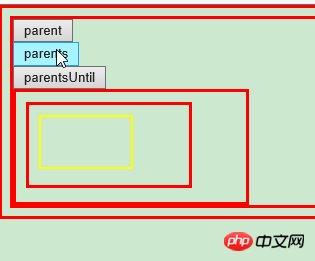

2. Traverse the DOM downwards Tree, find the descendants of elements
Use: children() method, find() method.
<html>
<head>
<meta http-equiv="Content-Type" content="text/html; charset=utf-8" />
<title>My Test JQuery</title>
<script type="text/javascript" src="./js/jquery-1.10.2.min.js"></script>
<script type="text/javascript">
$(function() {
//children() 方法返回被选元素的所有直接子元素。该方法只会向下一级对 DOM 树进行遍历。
//find() 方法返回被选元素的后代元素,一路向下直到最后一个后代。
$("#btn_children1").click(function() {
$("#myp1").children().css({
"color": "red",
"border": "3px solid red"
});
});
$("#btn_children2").click(function() {
$("#myp1").children("p.class1").css({
"color": "red",
"border": "3px solid red"
});
});
$("#btn_find1").click(function() {
$("#myp1").find("p").css({
"color": "red",
"border": "3px solid red"
});
});
$("#btn_find2").click(function() {
$("#myp1").find("*").css({
"color": "red",
"border": "3px solid red"
});
});
});
</script>
</head>
<body>
<button type="button" id="btn_children1">children</button><br/>
<button type="button" id="btn_children2">children_class1</button><br/>
<button type="button" id="btn_find1">findp</button><br/>
<button type="button" id="btn_find2">find*</button><br/>
<p id="myp1" style="width:210px;height:140px;padding: 10px;border:2px solid blue;">
<p id="myp2" style="width:140px;height:60px;padding: 10px;border:2px solid green;">
<p id="myp3" style="width:70px;height:40px;padding: 10px;border:2px solid yellow;">
<p id="myP1" style="width:50px;height:20px;padding: 3px;border:2px solid black;">
</p>
</p>
</p>
<p Class="class1" style="width:140px;height:30px;padding: 10px;border:2px solid green;">
</p>
</p>
</body>
</html>

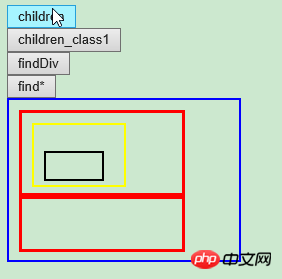
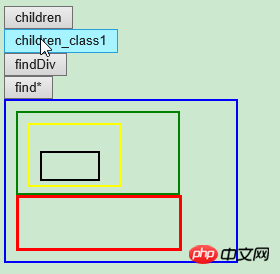
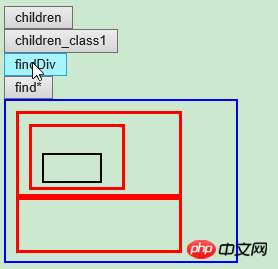
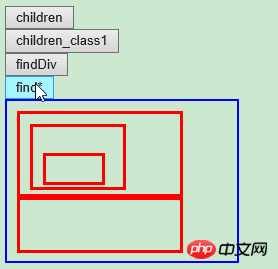
3. Traverse the sibling elements of the element:
Utilize: siblings() method, next() method, nextAll() method, nextUntil() method.
<!DOCTYPE html>
<html>
<head>
<meta http-equiv="Content-Type" content="text/html; charset=utf-8" />
<title>My Test JQuery</title>
<script type="text/javascript" src="./js/jquery-1.10.2.min.js"></script>
<script type="text/javascript">
$(function() {
//children() 方法返回被选元素的所有直接子元素。该方法只会向下一级对 DOM 树进行遍历。
//find() 方法返回被选元素的后代元素,一路向下直到最后一个后代。
$("#btn_siblings").click(function() {
$("#myp21").siblings().css({
"color": "red",
"border": "3px solid red"
});
});
$("#btn_next").click(function() {
$("#myp21").next().css({
"color": "red",
"border": "3px solid red"
});
});
$("#btn_nextAll").click(function() {
$("#myp21").nextAll().css({
"color": "red",
"border": "3px solid red"
});
});
$("#btn_nextUntil").click(function() {
$("#myp21").nextUntil("h5").css({
"color": "red",
"border": "3px solid red"
});
});
});
</script>
</head>
<body>
<button type="button" id="btn_siblings">siblings</button><br/>
<button type="button" id="btn_next">next</button><br/>
<button type="button" id="btn_nextAll">nextAll</button><br/>
<button type="button" id="btn_nextUntil">nextUntil</button><br/>
<p id="myp1" style="width:210px;height:190px;padding: 10px;border:2px solid blue;">
<p id="myp21" style="width:140px;height:20px;padding: 5px;border:2px solid green;">
</p>
<p id="myp22" style="width:140px;height:20px;padding: 5px;border:2px solid green;">
</p>
<p id="myp23" style="width:140px;height:20px;padding: 5px;border:2px solid green;">
</p>
<h5>Hello</h5>
<p id="myp24" style="width:140px;height:20px;padding: 5px;border:2px solid green;">
</p>
</p>
</body>
</html>
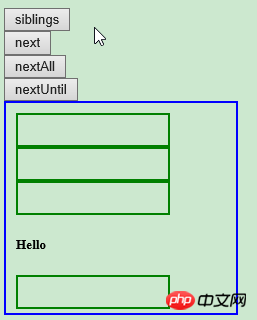

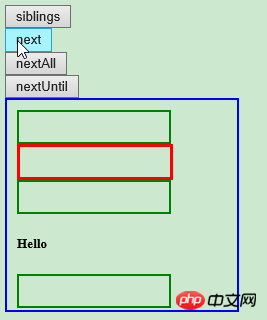
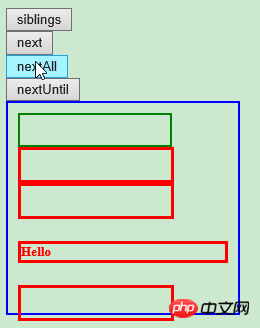

4. Filtering method: based on its presence in a set of elements Position to select a specific element
Use: first() method, last() method, eq() method, filter() method, not() method
<!DOCTYPE html>
<html>
<head>
<meta http-equiv="Content-Type" content="text/html; charset=utf-8" />
<title>My Test JQuery</title>
<script type="text/javascript" src="./js/jquery-1.10.2.min.js"></script>
<script type="text/javascript">
$(function() {
//first() 方法返回被选元素的首个元素。
//last() 方法返回被选元素的最后一个元素。
//eq() 方法返回被选元素中带有指定索引号的元素。
//filter() 方法允许你规定一个标准。不匹配这个标准的元素会被从集合中删除,匹配的元素会被返回。
//not() 方法返回不匹配标准的所有元素。
$("#btn_first").click(function() {
$("#myp1 p").first().css({
"color": "red",
"border": "3px solid red"
});
});
$("#btn_last").click(function() {
$("#myp1 p").last().css({
"color": "red",
"border": "3px solid red"
});
});
$("#btn_eq").click(function() {
$("#myp1 p").eq(2).css({
"color": "red",
"border": "3px solid red"
});
});
$("#btn_filter").click(function() {
$("#myp1 *").filter("h5").css({
"color": "red",
"border": "3px solid red"
});
});
$("#btn_not").click(function() {
$("#myp1 *").not("h5").css({
"color": "red",
"border": "3px solid red"
});
});
});
</script>
</head>
<body>
<button type="button" id="btn_first">first</button>
<button type="button" id="btn_last">last</button>
<button type="button" id="btn_eq">eq</button>
<button type="button" id="btn_filter">filter</button>
<button type="button" id="btn_not">not</button>
<p id="myp1" style="width:210px;height:190px;padding: 10px;border:2px solid blue;">
<p id="myp21" style="width:140px;height:20px;padding: 5px;border:2px solid green;">
</p>
<p id="myp22" style="width:140px;height:20px;padding: 5px;border:2px solid green;">
</p>
<p id="myp23" style="width:140px;height:20px;padding: 5px;border:2px solid green;">
</p>
<h5>Hello</h5>
<p id="myp24" style="width:140px;height:20px;padding: 5px;border:2px solid green;">
</p>
</p>
</body>
</html>
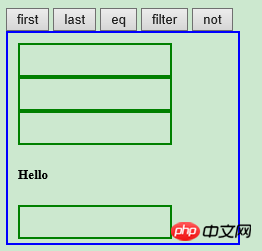
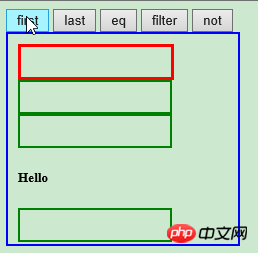
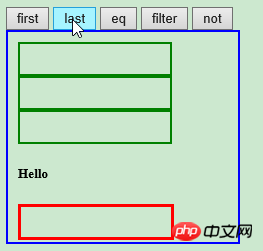
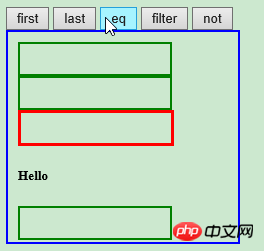
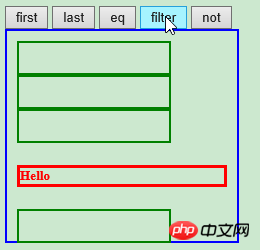
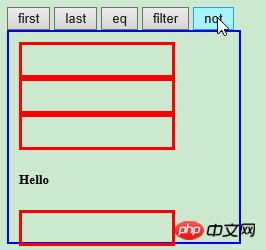
Summary: The above is the entire content of this article, I hope it will be helpful to everyone's study.
The above is the detailed content of What is the use of jQuery traversal? Implementation of jQuery traversal. For more information, please follow other related articles on the PHP Chinese website!
Related articles
See more- An in-depth analysis of the Bootstrap list group component
- Detailed explanation of JavaScript function currying
- Complete example of JS password generation and strength detection (with demo source code download)
- Angularjs integrates WeChat UI (weui)
- How to quickly switch between Traditional Chinese and Simplified Chinese with JavaScript and the trick for websites to support switching between Simplified and Traditional Chinese_javascript skills

